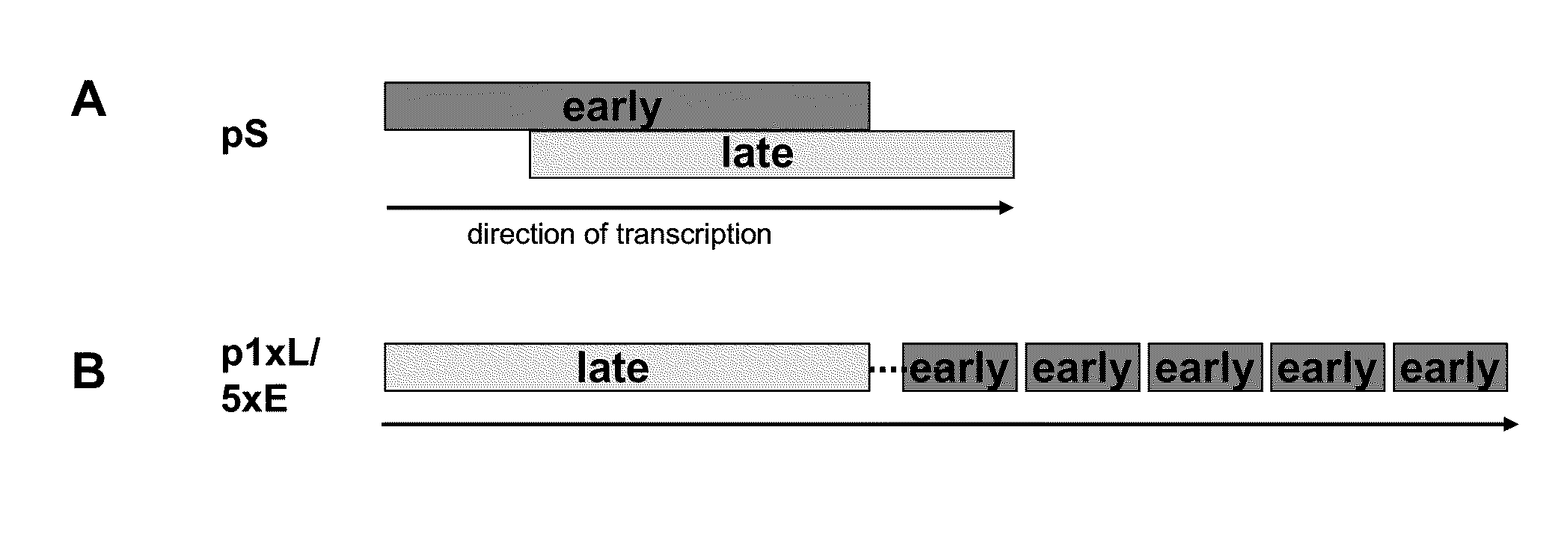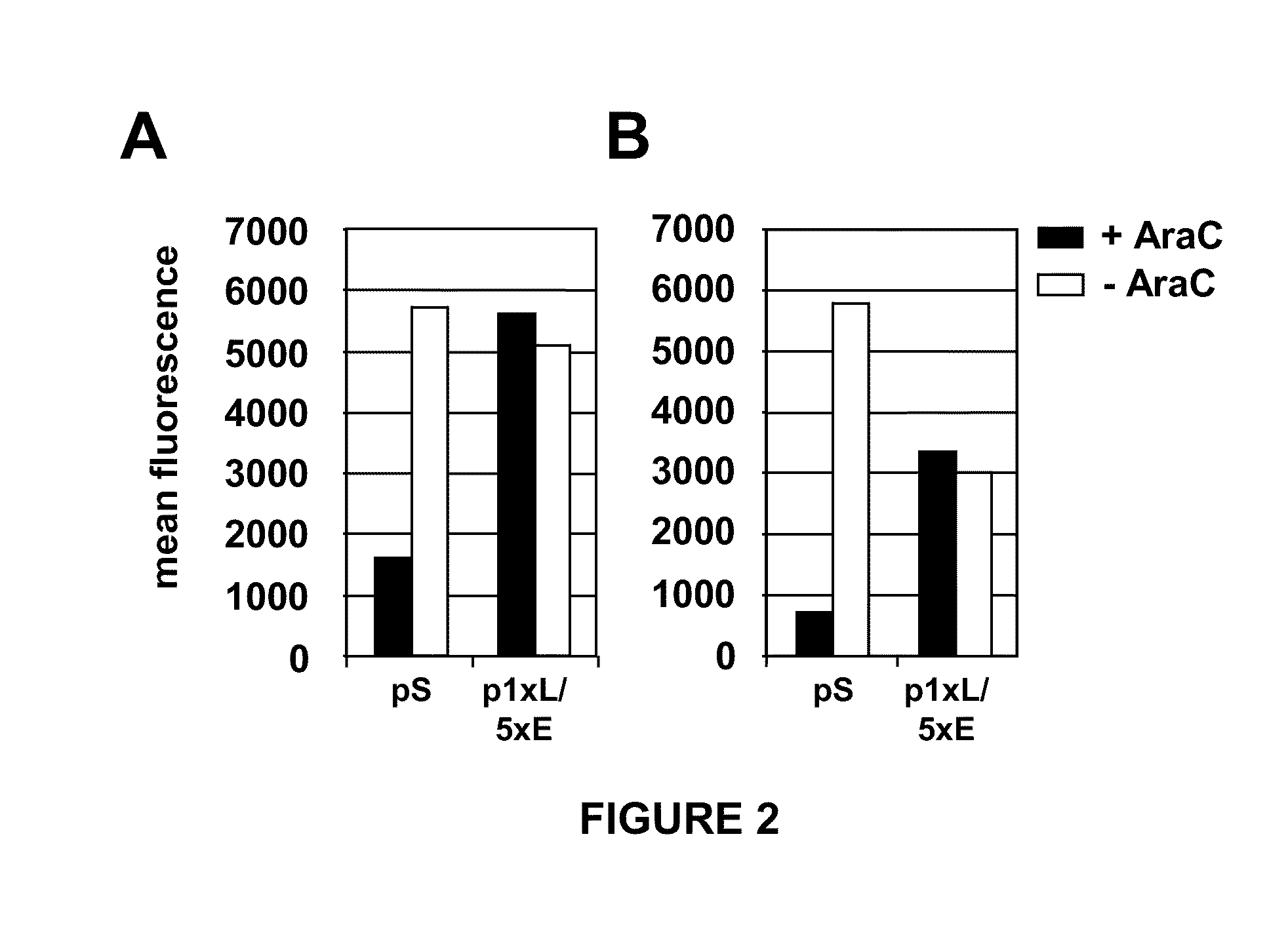Optimized early-late promoter combined with repeated vaccination favors cytotoxic t cell response against recombinant antigen in mva vaccines
- Summary
- Abstract
- Description
- Claims
- Application Information
AI Technical Summary
Benefits of technology
Problems solved by technology
Method used
Image
Examples
example 1
Generation of MVA Recombinants
[0094]A synthetic late / early promoter designated p1xL / 5xE containing a late element and five tandemly arranged early promoter elements was constructed (FIG. 1) and is designated “early / late hybrid promoter” throughout. The late element was derived from the promoter directing the expression of the A-type inclusion (ATI) protein. The five early elements are all identical and were derived from the immediate early p7.5 promoter. They were further optimized according to the consensus sequence for early vaccinia virus promoters. (Broyles, S. S., Vaccinia virus transcription. J. Gen. Virol. 84:2293-2303, 2003; Chakrabarti, S., J. R. Sisler, and B. Moss, Compact, synthetic, vaccinia virus early / late promoter for protein expression. Biotechniques 23:1094-1097, 1997; Davison and Moss, J. Mol. Biol. 210:749-769, 1989.)
[0095]This promoter was compared with the well-defined synthetic “pS” promoter (FIG. 1) constructed by Chakrabarti et al., 1997, which has been show...
example 2
Promoter-Dependent Gene Expression Levels In Vitro
[0096]The expression efficiency of the eGFP reporter gene under control of promoters pS and p1xL / 5xE was determined using cell cultures infected with the respective recombinant MVA viruses.
[0097]The pS promoter appeared to direct higher expression than the p1xL / 5xE promoter in untreated cells permissive for MVA (CEF, FIG. 2B). In contrast, eGFP expression in untreated non-permissive cells was similar with both promoters (FIG. 2A). Non-permissive cells supposedly mimic the in vivo situation of MVA infection more accurately than the permissive CEF cells suggesting that overall expression directed by the two promoters in vivo might be similar. Importantly, the p1xL / 5xE promoter directed much higher early eGFP expression than the pS promoter when infection was arrested in the early phase by AraC treatment (FIG. 2), indicating that the early portion of p1xL / 5xE was stronger than that of the pS promoter, suggesting that proteins expressed ...
example 3
Analysis of CD8 T Cell Responses
[0098]CD8 T cell responses against recombinantly expressed OVA under control of the promoters pS and p1xL / 5xE were determined in C57BL / 6 mice after one, two, and three immunizations with 108 TCID50 recombinant MVA per mouse. The OVA-specific CD8 T cell response was determined by assessing the number of CD8 T cells secreting IFN-γ following a 5-hour stimulation with the Kb-restricted OVA-derived peptide SIINFEKL (OVA257-268 SIINFEKL; SEQ ID NO:3). To monitor the CD8 T cell response to the MVA vector, CD8 T cells secreting IFN-y upon recognition of the immunodominant CD8 T cell epitope of MVA (Tscharke et al., JEM 201:95-104, 2005) derived from the viral B8R protein (B8R20-27TSYKFESV; SEQ ID NO:4) were quantitated.
[0099]Briefly, immunized animals were bled from the tail vein and 120 μl of blood per mouse was resuspended in 2 ml of PBS pH 7.4 containing 4% fetal calf serum (FCS), 2 mM ethylenediaminetetraacetic acid (EDTA) and 2.5 U / ml heparin. Blood sam...
PUM
| Property | Measurement | Unit |
|---|---|---|
| Fraction | aaaaa | aaaaa |
| Fraction | aaaaa | aaaaa |
| Fraction | aaaaa | aaaaa |
Abstract
Description
Claims
Application Information
 Login to View More
Login to View More - R&D
- Intellectual Property
- Life Sciences
- Materials
- Tech Scout
- Unparalleled Data Quality
- Higher Quality Content
- 60% Fewer Hallucinations
Browse by: Latest US Patents, China's latest patents, Technical Efficacy Thesaurus, Application Domain, Technology Topic, Popular Technical Reports.
© 2025 PatSnap. All rights reserved.Legal|Privacy policy|Modern Slavery Act Transparency Statement|Sitemap|About US| Contact US: help@patsnap.com



